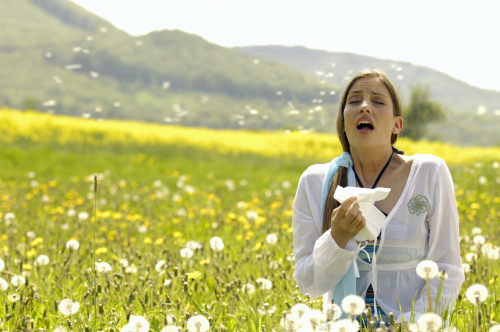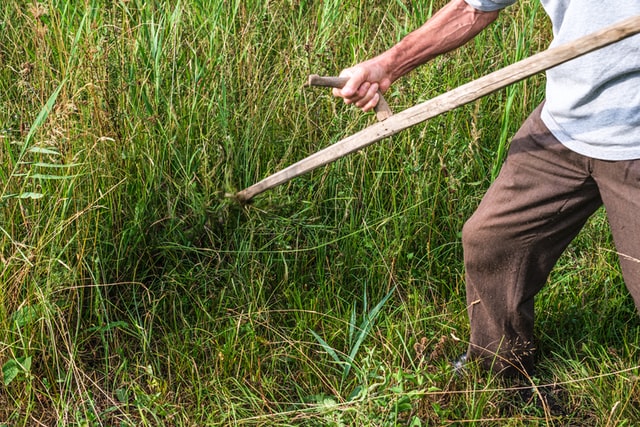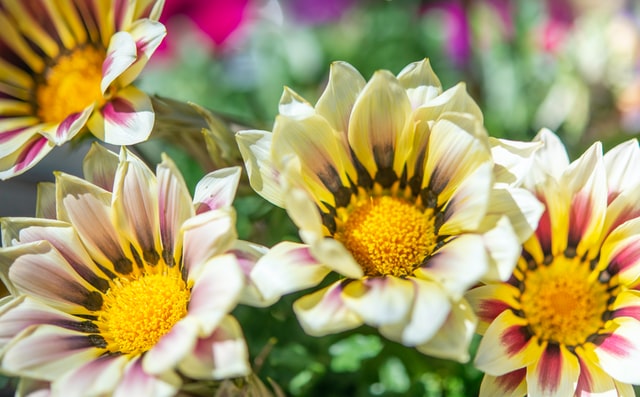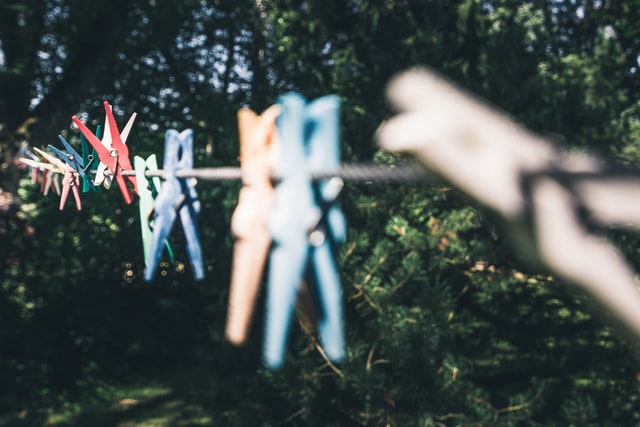Log in or create new account to save this product to your wishlist.
8 lawn care tips for hay fever sufferers
Hay fever can make summer a pretty miserable time of year. Check out our tips for minimising the triggers!
Latest blogposts
7 MIN 22 Jul How to keep your lawn in shape this summer 9 MIN 15 Jul Watering Your Garden: 10 Top Tips! 11 MIN 15 Jul Is Your Grass Type Right for your Garden? 4 MIN 03 Sep Gardening in September — jobs to do 7 MIN 23 Aug How to Encourage Bees in Your Garden 5 MIN 14 Aug Pruning Lavender: when, why and how?If – like 25% of the UK population – you sneeze and weep your way through the summer, those warmer middle months can feel a little incapacitating. And while everyone else is out enjoying BBQs in the sunshine, an invite to an outdoor event can feel like a bit of an ordeal.
So, if you want to enjoy your lawn during hay fever season, there are some steps to take to help ensure you can both breathe easily AND still take care for your lawn.
This article is all about lawn care tips for hay fever sufferers, helping those of us afflicted with this annoying condition to enjoy the sunshine like everyone else.
What are the symptoms of hay fever?

Hay fever affects everyone in different ways – and sometimes, our symptoms are exacerbated by vehicle and fuel emissions rather than pollen.
You may experience some or all of these symptoms:
- Sneezing/coughing
- Runny or blocked noise
- Red, itchy, watery eyes
- Sore, scratchy throat, nose, mouth, or ears
- Loss of smell
- Headache or pain around your forehead and temples
- Earache
- Fatigue
You could easily mistake hay fever for a cold or even the flu. Some people are hit heavily with fatigue and headache, while there are few visible symptoms such as a runny nose or watery eyes.
What is your allergy?
First of all, it’s helpful to understand your condition. Some people only experience hay fever symptoms during a small window of the year. In contrast, others experience symptoms all year round.
So, before you rush for the antihistamines, try to learn a bit about your individual condition.
We all assume that grass pollens are the culprit, but if you seem to come down with flu-like symptoms at the same time every year, it could be tree pollen. Or weed pollen.
It takes a little time to diagnose your symptoms, but whenever your hay fever flares up, look online to find out which pollen types are active in the air.
Check out the Met Office pollen count to determine which pollen types are active in your area. And, from there, work out which pollens most often trigger your symptoms. Alternatively, Kleenex offers a very accurate breakdown of the pollens affecting your air.
So, how might you reduce the possibility of triggering your hay fever?
1. Maintain your lawn

Many hay fever sufferers are sensitive to grass and weed pollens. So, the most obvious way to minimise these pollens from reaching the air in the first place is to mow regularly.
Mowing your lawn once a week during the summer is beneficial for your grass plants (because mowing boosts growth) and prevents flowering, meaning that your lawn will produce less pollen.
If you’re allergic to grass pollen, you could spray your lawn with water before you start gardening – this will help prevent pollen particles from spreading into the air. Of course, mowing a wet lawn is never a good idea, so make sure it’s a very light watering if you’re planning on getting the mower out.
If this doesn’t work or isn’t practical, try wearing a face mask (we all have several of these lying around the house after the pandemic!). Alternatively, wear a hat – covering your head prevents pollen from sticking to your hair. And wear gloves to avoid spreading pollen from your hands to your face.
And when you’ve finished working in the garden, change your clothes and wash them straight away – this way, you won’t spread pollen around the house.
Check out our expert’s guide to mowing your lawn for professional cutting tips.
2. Weed your lawn
Weed pollens can be particularly potent, especially dandelions, creeping thistle, and ragwort. So, removing weeds from your lawn and garden is a good idea – before they have a chance to break into flower.
Pull out weeds from the roots; otherwise, they’ll just keep coming back.
Also, check your soil’s acidity – weeds love acidic soil while your grass requires pH neutrality to thrive. Apply Lawn Lime to your lawn soil to neutralise the acidity, making your lawn more inhospitable to weeds.
Additionally, fertilise your lawn regularly to prevent weeds. A healthy lawn is less likely to be invaded by weeds, while a weak turf with lots of bald patches is a very welcome home for weeds.
Check out our expert’s guide to fertilising your lawn for the best possible outcome.
3. Choose the correct plants

Hay fever is an allergic response to (usually) air-born pollutants, such as dust, air pollution, and pollen. So, if you want to enjoy your garden during the summer, avoid wind-pollinated plants and trees.
The most common wind-pollinating trees are ash, sycamore, oak, horse chestnut, and hazel. So, avoid planting these in your garden.
Opt for fruit trees, such as apple, pear, cherry, or plum – these release the lowest allergens.
Some plants are better than others. For example, flowering plants such as iris, delphinium, geranium, and lobelia produce beautiful flowers without polluting the air.
Generally speaking, insect-pollinated plants that attract bees and other flying insects tend to be better for hay fever sufferers because they don’t spread their pollen into the air. This is because insect-pollinated plants produce heavier pollens that drop to the ground rather than float into the air.
So, it’s a win-win for the bees and a more comfortable summer for you!
4. Wash your clothes (and body) more regularly

It’s easy to bring pollen into your home even if you keep the windows tightly shut. And pollen indoors is just as bad for allergic reactions as outdoor pollen.
So, whenever you go outside during high-pollen days, change your clothes as soon as you get back inside to prevent spreading pollen that may have stuck to the cloth. 00
And don’t forget to wash your hands, face, and hair regularly, preventing pollen from reaching your nose, mouth, ears, and eyes.
Additionally, avoid hanging your clothes to dry outside – your clothes become a magnet for airborne pollens.
5. Use a sprinkler

Reduce airborne pollen by running your lawn sprinkler when the pollen count is high. This won’t capture all of the pollen, but it will reduce the amount you experience when you first go out into your garden – a great tip if you want to do a little bedding work or water your veg.
6. Garden in the afternoon
A good rule of thumb is to tend to your garden in the afternoon because the pollen count is generally lower than in the morning.
Also, limit your gardening to cloudy and cool days or after rainfall – the air will be clearer and more likely to be pollen-free.
7. Eat well

Now, this may seem like a rather odd suggestion, but eating plenty of fruit and veg can help boost your immune system due to a boost of vitamin C, which offers an antihistamine effect.
Opt for anti-inflammatory, de-caffeinated drinks such as green tea if your nose is running or blocked. Avoid caffeine because it can trigger the histamine response that tells your body to attack the harmless pollen that enters your body through your nose, eyes, and ears.
8. Plant female trees only
Yes, there are male and female trees! And while female trees produce the seeds, pods, and fruit, their male counterparts release the pollen.
According to Scientific American, female trees trap pollen in the air, removing the allergens that could trigger your symptoms.
Now, gendering a tree is quite a complicated process, especially as many trees produce flowers that release pollen (male) AND flowers that contain ovaries (female) that bear fruit. So, trees that bear flowers of both sexes (known as monoecious) will release pollen, while it’s dioecious trees that produce flowers of just one sex – and female dioecious trees don’t release pollen.
So, next time you’re looking in your garden centre for a fruit tree to add to your garden, go for female dioecious varieties. Ask a member of staff if you’re not sure.
Do you still have questions?
I hope you’ve got all the information you could need about minimising your chances of aggravating your hay fever symptoms this summer. But if you have a question, don’t hesitate to get in touch.
We love to hear from you – so drop us an email, and we’ll reply tout suite.
Leave a comment
Your answer will be displayed on the site and the interested party will be notified by email.
Leave a comment
Have a question or want to share your experience? Leave us a comment.
Read more
The best tips and tricks for a lush green lawn
 Scarifying Kit
All products after scarifying | Quickly restores the lawn after scarifying | Outsmart weeds quickly with the use of this kit
From: € 39.99
Scarifying Kit
All products after scarifying | Quickly restores the lawn after scarifying | Outsmart weeds quickly with the use of this kit
From: € 39.99
 Spring Lawn Care Kit
MOOWY’s choice for the spring | Quick recovery of your lawn after winter | A strong lawn prevents weeds
From: € 25.99
Spring Lawn Care Kit
MOOWY’s choice for the spring | Quick recovery of your lawn after winter | A strong lawn prevents weeds
From: € 25.99
 Long Lasting Lawn Fertiliser
Effective for 90 days | See results in 14 days! | Suitable for all types of grass and soil
From: € 13.99
Long Lasting Lawn Fertiliser
Effective for 90 days | See results in 14 days! | Suitable for all types of grass and soil
From: € 13.99
Do you want a lawn calendar?
🌱 All important maintenance moments for your lawn during the year. Leave your email and we will send you the lawn calendar for free.
Enter your email
Receive the lawn calendar in the mail
Enjoy a green lawn all year round!









Comments (0)
There are no comments yet. Well then, what are you waiting for to
Be the first to write your comment!inaugurate this pretty page?
Do you have some comments?